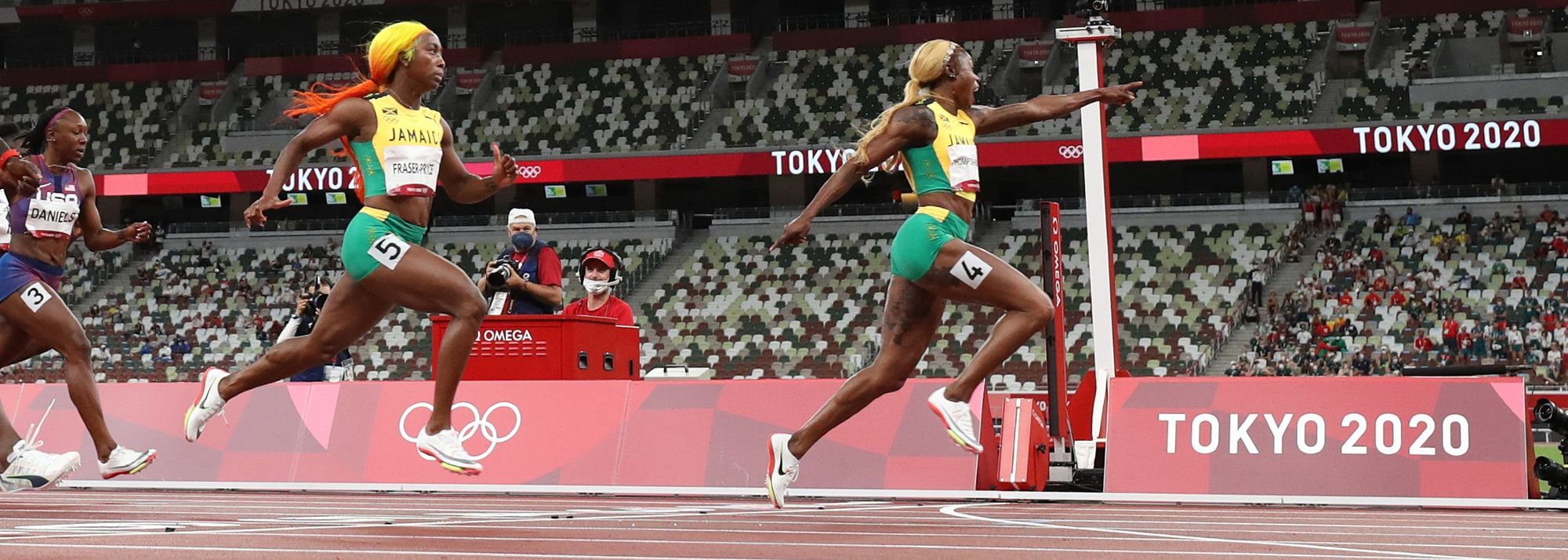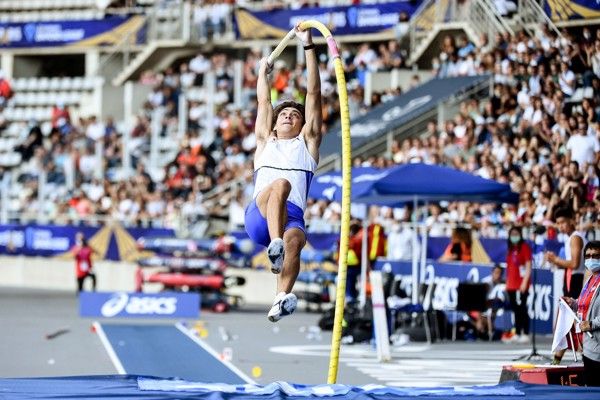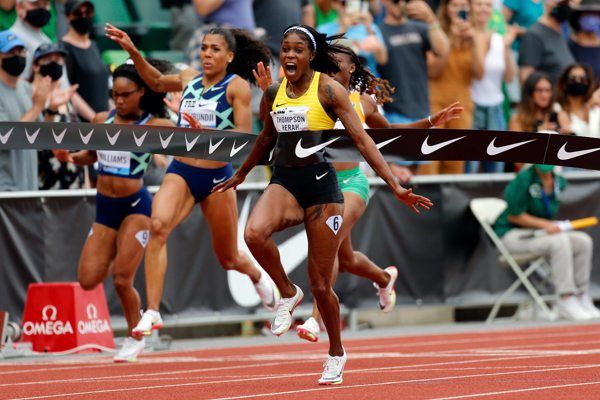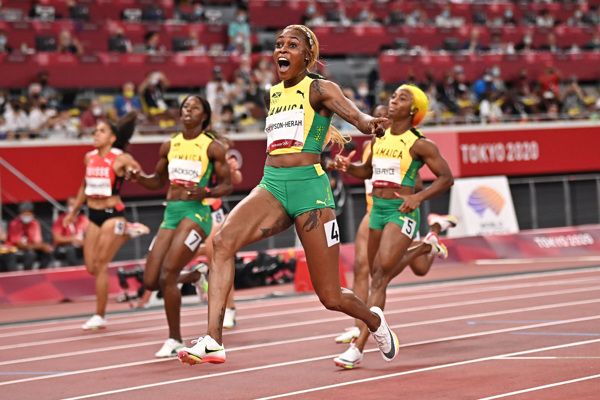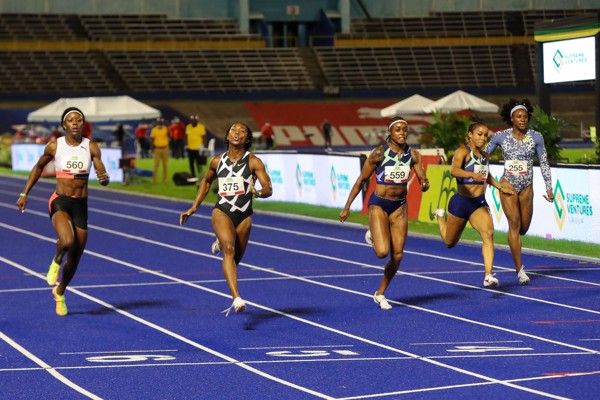Elaine Thompson-Herah and Shelly-Ann Fraser-Pryce at the Tokyo 2020 Olympic Games (© Getty Images)
There was a time when the ultimate goal for Shelly-Ann Fraser-Pryce and Elaine Thompson-Herah was to make it on to the winner’s podium at Champs.
These days, the major motivating prize on the horizon for Jamaica’s dashing dynamic duo has become a place (or possibly two) in the world record books.
As the Great Jamaican Women’s Sprint Extravaganza rolls on into the final few weeks of this scorching 2021 season, however, you can’t help but think of the generating force of the Jamaican phenomenon known as ‘Champs’.
The National Boys’ and Girls’ Schools Athletics Championships has to be seen to be believed. It is a Jamaican institution and one of the truly great experiences on the track and field spectrum.

Tyreke Wilson wins the class-3 100m at the Boys and Girls Championships in Jamaica (© Jean-Pierre Durand)
For five days, this joyous carnival sprint production show packs Kingston’s National Stadium to its 30,000 capacity. It is the talk of the national radio shows and fills the front and back pages of Jamaica’s national newspapers. Every second of the action is screened live on national TV.
High school students and alumni come dressed in school colours and make a partisan racket with their drums, horns and thunder sticks. Dotted around the packed-full bleachers, you can spot the graduates who made it to the top, all sporting their old school colours.
Back in 2003, running for William Knibb Memorial High School, a certain Usain Bolt won the boys’ class one (age 16 to 19) 200m in 20.25.
Such is the jaw-dropping standard and depth of the high-speed sprinting on display, Thompson-Herah never managed to get on to the podium. Running for Manchester High, she finished fourth in the class two girls’ 100m, clocking 12.00.
Fraser-Pryce only won the once. In 2004, as a 16-year-old representing Wolmer’s High School for Girls, she took the class two girls’ 100m in 11.73.
Nine years later, she could be seen, clad in Wolmer’s colours, enjoying the action from the bleachers. The next morning, at a sprightly 7am, she reported for training up the road from Bob Marley’s old house, still buzzing from the infectious Champs vibe.
“That’s what Champs does to you,” she said, beaming her infectious smile. “It’s the whole atmosphere and the excitement about how everybody’s competing. And sitting there cheering for your old school.
“The time I won is always with me. It was huge. When I crossed that line, and I knew I had that gold medal, I heard all my schoolmates cheering for me. I thought, ‘This is it.’
“Yesterday on the track there was this little 12-year-old girl running 11.75. I was running 12-high at that age. The performances are just amazing. And there are so, so many of them. It just shows the huge talent base we have here in Jamaica. It also shows that our senior athletes are providing such a huge motivation for these young athletes in school.
“They go out and compete just as if they were competing at an Olympics or World Championships.”
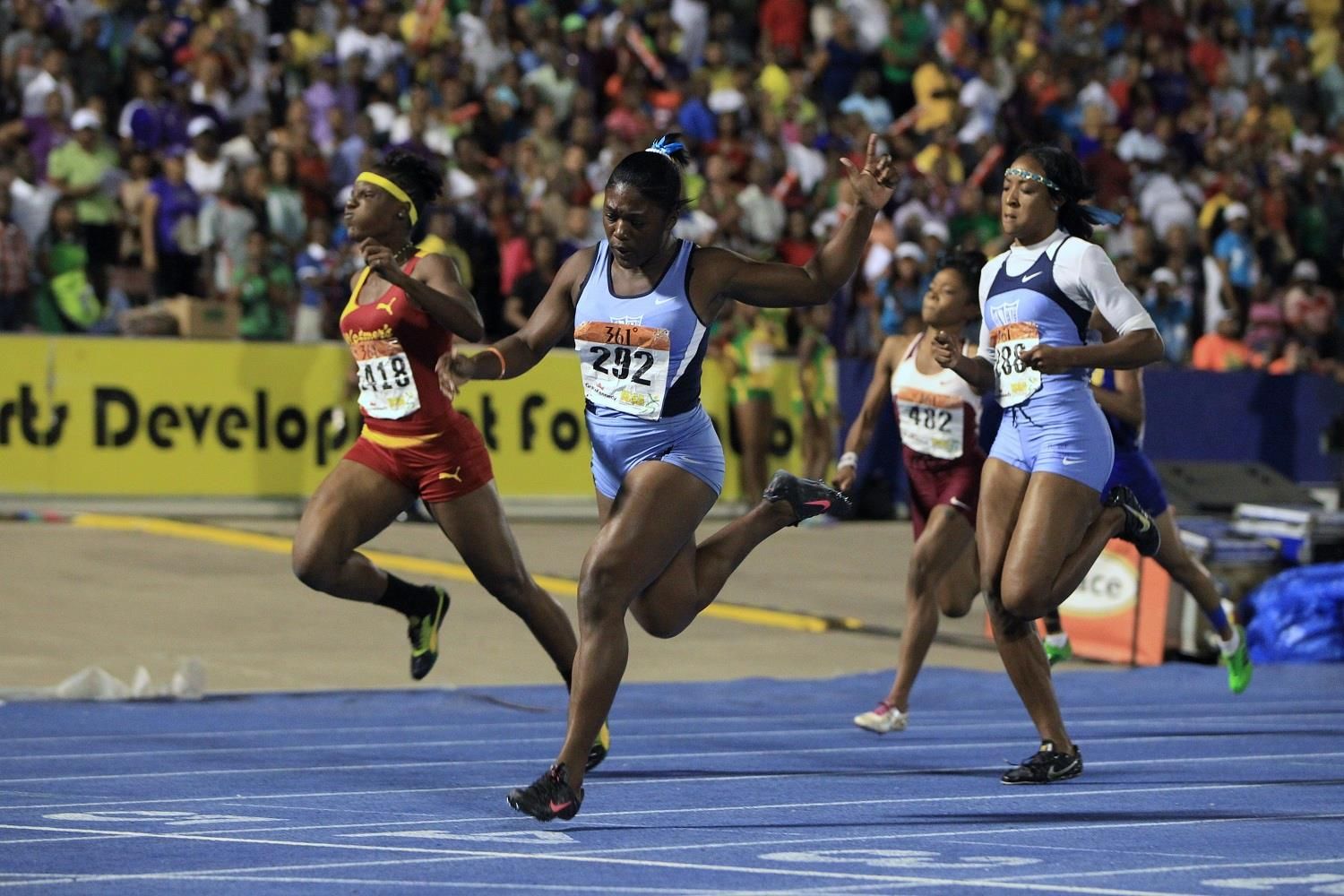
Christania Williams wins at the 2014 Boys and Girls Championships (© Jean-Pierre Durand)
There is so much more involved, of course, in propelling the champs of Champs, and some of the also-rans, on to the Olympic and World Championships stage – and onwards towards threatening the world record books.
Significantly, however, the home-based sprint groups in which Fraser-Pryce, Thompson-Herah and the whole raft of world class Jamaican sprint stars have thrived are all filled with fellow products of the ultra-competitive, ultra-high-speed Champs system.
The sprint gurus who coach them also learned their trade through Champs.
Stephen Francis, who guides Thompson-Herah and who plotted Fraser-Pryce’s career until early last year, set up his MVP (Maximum Velocity and Power) stable in 1999 specifically to harness the sprint talent from Champs. He got into coaching by volunteering to help out at Wolmer’s Boys’ School, where he had been a thrower in his youth.
Reynaldo Walcott, who now guides Fraser-Pryce, is best known in Jamaica as head coach of St Elizabeth Technical High School. He helped Francis at MVP before branching out on his own with the Elite Performance Track Club. He is also a pineapple farmer.
And so to the fruits of their labour in this season of rich 100m pickings…
First Fraser-Pryce blazed a 10.63 at the Olympic Destiny meet in Kingston on 5 June to claim second place on the world all-time list, behind Florence Griffith-Joyner’s 10.49.
Then Thompson-Herah uncorked a 10.61 in the Olympic final in Tokyo on 31 July, eclipsing Griffith-Joyner’s 33-year-old 10.62 Olympic record – followed by a scorching 10.54 in the Wanda Diamond League meeting in Eugene on 21 August.
Then Fraser-Pryce countered with a stunner of her own: a 10.60 in the chill wind of Lausanne, five days later (26 August).
The remarkable 34-year-old Fraser-Pryce might have arrived in Lausanne in the shadow of her 29-year-old compatriot, having finished 0.13 behind Thompson-Herah as runner up in the Olympic final, and 0.19 adrift in Eugene, but she insisted her best was still to come – and she duly delivered with her 10.60 lifetime best, taking her tally of sub-10.80 clockings to 21.
The performance came at the cost of reported tiredness that ruled out a rematch at the Diamond League fixture two days later in Paris (21 August), where Thompson-Herah prevailed in a 10.72 meeting record, her sixth sub-10.80 of 2021 and her fifth-fastest time of the season.
After the whirlwind of action, with two weeks of the Diamond League season remaining, the all-time list now reads: 10.49 Griffith-Joyner, 10.54 Thompson-Herah, 10.60 Fraser-Pryce.
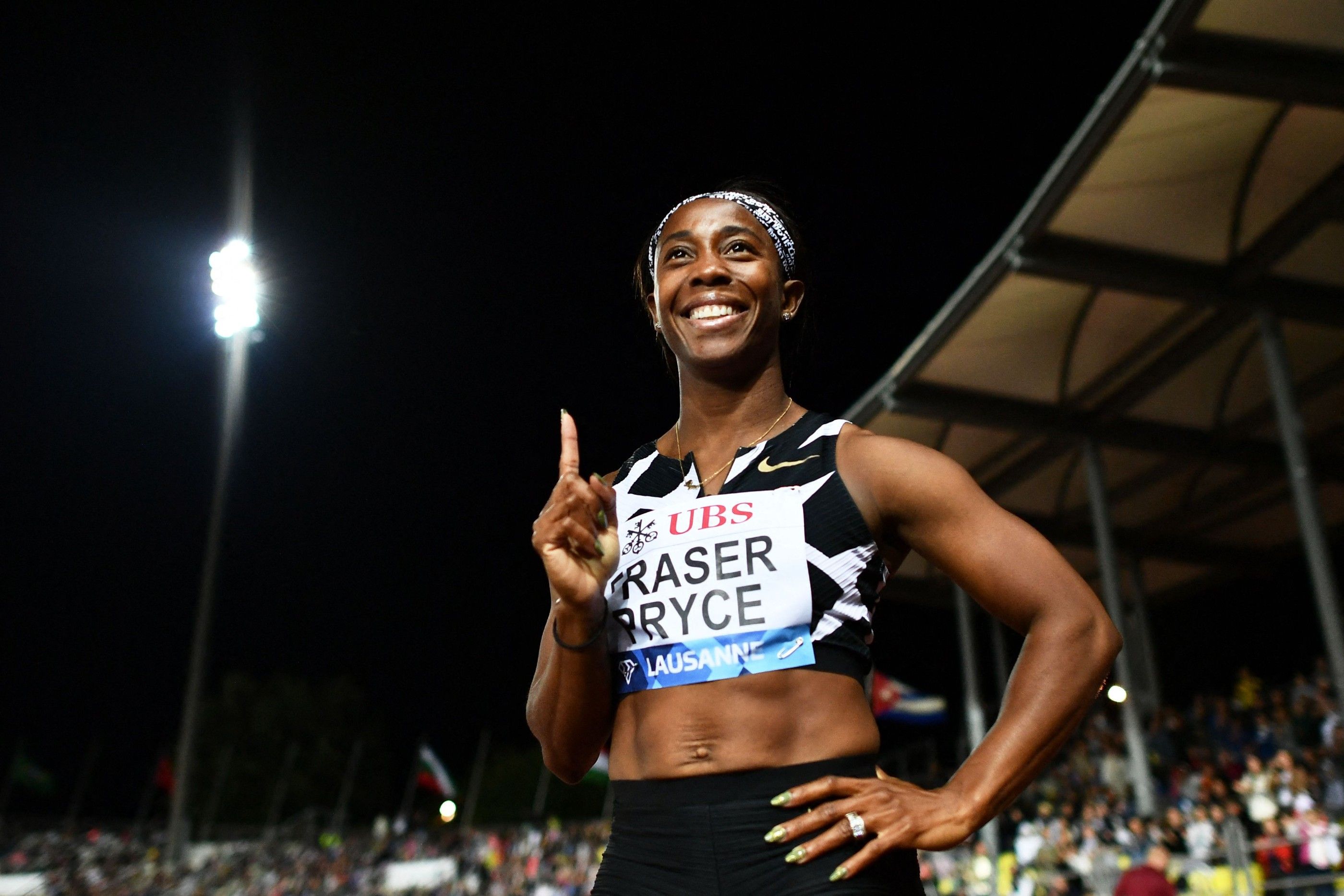
Shelly-Ann Fraser-Pryce celebrates her 100m win at the Wanda Diamond League in Lausanne (© AFP / Getty Images)
Underestimated all her life – at 5ft, being told she was too small to be a world class sprinter – Fraser-Pryce has entered the great world record equation. Or “conversation,” as she puts it.
She might be four months shy of her 35th birthday, with a son, Zyon, who has just turned four, but the ray of Caribbean sunshine who was raised in abject poverty in the Kingston ghetto of Waterhouse (she ran barefoot when she finished second in the national primary school championships because her mother could not afford to buy her a pair of spikes or training shoes) maintains even after her latest advance that her best is still to come.
“There will be more to come from me this season,” said Fraser-Pryce. “Certainly, my goal is to break into the 10.5 range.
“I definitely have not run my best race as yet. I am still working on different phases of the races, and hopefully I’ll be able to put that together.
“Elaine is closer to the world record. It’s good to be able to challenge a record that, for women, we thought for a long time was impossible. It speaks to the evolution of sprinting and what mechanics can do to sprinting. To be in that conversation, or even to have that conversation, is truly remarkable.
“Seeing women sprinting at this level is remarkable. I’m glad that I’m able to be in that field and in the conversation. I’ve been running for some years and to see female sprinting finally being on top, the way it should have been for years, just speaks to the calibre of athletes that we have coming.
“Nobody comes up to the line showering you with flowers. Everybody’s there to get the victory. To have women you know definitely will bring it and will have fast times, I think that adds to the excitement. Not only for the crowd but for you as an athlete because it forces you to raise your game
“It forces you to make sure that every time you step on the line, you’re bringing your A game.”
That’s also the case in the 200m, of course. Fraser-Pryce ran a lifetime best 21.79 at the Jamaican trials in Kingston on 27 June, the last occasion before Lausanne on which she managed to get the better of Thompson-Herah, which she also did in the 100m.
Gabby Thomas moved second to Griffith-Joyner’s 21.34 world record with 21.61 at the US trials the day before, but then Thompson-Herah uncorked her 21.53 to win in Tokyo.

Elaine Thompson-Herah on her way to a 100m win at the Wanda Diamond League meeting in Paris (© AFP / Getty Images)
Between them, Fraser-Pryce and Thompson-Herah have amassed a Fort Knox of global medals.
Including relays, Fraser-Pryce boasts three Olympic golds and one silver, plus nine World Championships golds and one silver. Thompson-Herah has five Olympic golds and one silver, one world gold (in the 4x100m relay) and one silver.
The Jamaican sprinting phenomenon that manifested itself at the Beijing Olympics, with Usain Bolt completing the men’s double and Fraser-Pryce (100m) and Veronica Campbell-Brown (200m) taking the women’s golds is still flourishing on the female side.
Behind the two current main players, Shericka Jackson – three times a global bronze medallist at 400m – has emerged as world No.3 in the 100m. She took bronze in 10.76 in Tokyo and finished third in both Eugene and Lausanne, then runner up to Thompson-Herah in Paris.
Thompson-Herah hails from Manchester, the parish where Canada’s 1996 Olympic men’s 100m champion Donovan Bailey was born and raised before his family emigrated.
She joined MVP after leaving Manchester High School and made her mark in 2016, completing the 100m-200m double at the Rio Olympic Games.
Having become only the second back-to-back double Olympic sprint champion, after Wyomia Tyus of the USA, the Champs also-ran now has her sights on a place in the world record books.
“For me to run a 10.54, that makes me think it’s definitely in reach,” said Thompson-Herah. “It’s shows you that anything is possible.
“It is possible to break a FloJo record and I would love to do that, of course. I don’t think I’m perfect yet but I’m working on it. There’s more work to go to get that time.
“When I ran 10.54 in Eugene, I knew that once I hit that target other persons will say ‘I can do that too’.
“I know Shelly-Ann is a hard-working woman. And the fact that she is running so fast at 34 gives me motivation that I can do it again at the next Olympics in Paris when I am 32.
“She has done it, so I can do it too.”
Simon Turnbull for World Athletics

